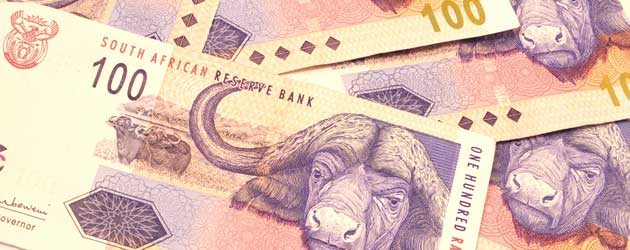 South African Rand (ZAR) Exchange Rate Forecast
South African Rand (ZAR) Exchange Rate Forecast
The emerging-market South African Rand was struggling against Pound Sterling (GBP/ZAR) and the US Dollar (USD/ZAR) on Thursday in spite of a better-than-forecast manufacturing report for South Africa.
Although economists had predicted that the level of Manufacturing Production in South Africa would have declined by 2.1% in June, year-on-year, it actually increased by 0.5%. However, the Rand went on to slide by over 0.3% against its US peer as a separate economic report for South Africa failed to impress.
The nation’s Business Confidence Index plunged to a 15-year low amid ongoing unrest in the domestic labour market and global economic concerns.
The weakness in the South African Rand (ZAR) exchange rate saw analyst Christie Viljoen comment; ‘The manufacturing numbers were reassuring but there is no reason to be over optimistic.’ Economic reports for South Africa are lacking today, but next week sees the release of Retail Sales and Mining Production figures for the commodity-driven nation.
Australian Dollar (AUD) Exchange Rate Forecast
A shocking jump in Australia’s Unemployment Rate left the Australian Dollar struggling against the majority of its most-traded currency counterparts on Thursday.
The Pound Sterling to Australian Dollar (GBP/AUD) exchange rate was even able to hold on to its over 0.7% advance as the Bank of England delivered an uninspiring interest rate decision and investors dwelt on yesterday’s lacklustre UK economic reports.
According to industry expert Annette Beacher; ‘Unemployment actually jumped to 789,000 after what was a flat trend. We need to see this indicator fall over the coming months as a trigger for the RBA to shift away from its entrenched neutral bias.’
Before the publication of China’s Trade Data and the Reserve Bank of Australia’s quarterly fiscal policy statement the Australian Dollar was also trending in weakened position against the US Dollar. However, upbeat Chinese trade figures could help the Australian Dollar stage a comeback before the weekend. The Pound Sterling to Australian Dollar (GBP/AUD) exchange rate could also fluctuate in response to the UK’s own trade figures.
New Zealand Dollar (NZD) Exchange Rate Forecast
Before New Zealand’s Finance Minister Bill English delivered a speech to the Waikato Chamber of Commerce, the New Zealand Dollar (NZD) exchange rate was stronger against peers like the Euro.
Although this week’s mixed employment figures for New Zealand and a drop in dairy prices reduced the appeal of the South Pacific currency earlier in the week, the New Zealand Dollar was able to stage a rebound. The gains in the New Zealand Dollar to Euro (NZD/EUR) exchange rate were largely due to the less-than-upbeat commentary offered by the European Central Bank in the wake of its latest interest rate decision.
While referring to concerns ranging from the situation in Ukraine to Italy returning to recession, the ECB’s President Mario Draghi intimated that external and internal pressures could impact the Eurozone’s recovery. As observed by market strategist Kymberly Martin; ‘Commentary from ECB president Draghi helped inspire a weaker Euro. Draghi sounded more down-beat on the economic outlook, leaving the door open for further stimulus measures. He said the bank is about to consult on the purchase of asset back securities.’
The New Zealand Dollar was also able to eke out a modest gain against the US Dollar (NZD/USD). As the day progresses, Germany’s trade figures are likely to have the biggest impact on the New Zealand Dollar to Euro (NZD/EUR) exchange rate.
UPDATED: 12:30 GMT 08 August, 2014
AUD, NZD, ZAR Soften as Risk-Off Environment Prevails
Higher risk currencies like the Australian Dollar (AUD), New Zealand Dollar (NZD) and South African Rand (ZAR) softened considerably on Friday as concerns regarding the building tensions in Gaza, Iraq and Ukraine saw investors take refuge with safe-haven assets.
Consequently, the Japanese Yen (JPY) adopted a bullish relationship with many of its currency counterparts. As stated by global markets expert Yasuhiro Kaizaki; ‘Geopolitical tensions are the market’s main focus, fuelling a flight to quality. In that risk-off environment, high-yield currencies are being sold in favour of the Dollar and Yen.’
The Aussie was 0.3% softer against the US Dollar and the New Zealand Dollar shed 0.4% against its North American rival. The Rand was steady for much of the local session on Friday, although economists believe it could drift lower as we head into the weekend.
Stay tuned for the latest exchange rate forecasts!

Comments are closed.